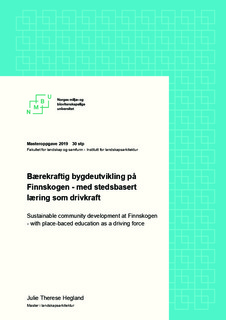| dc.contributor.advisor | Clemetsen, Morten | |
| dc.contributor.advisor | Stokke, Knut Bjørn | |
| dc.contributor.author | Hegland, Julie Therese | |
| dc.coverage.spatial | Norway, Finnskogen | nb_NO |
| dc.date.accessioned | 2019-08-19T11:25:26Z | |
| dc.date.available | 2019-08-19T11:25:26Z | |
| dc.date.issued | 2019 | |
| dc.identifier.uri | http://hdl.handle.net/11250/2609006 | |
| dc.description.abstract | Over hele landet har bygder og tettsteder store utfordringer med fraflytting og en stadig eldre befolkning. Effektivisering i primærnæringer som skog- og jordbruk fører til færre arbeidsplasser, og både offentlige og private tilbud flyttes til kommune- og regionsentrene som en effekt av sentralisering. Samtidig ligger det store verdier i distriktene i form av kultur- og naturarv, i tillegg til fornybare ressurser i skog og vassdrag. Disse verdiene bør ivaretas og videreutvikles i tråd med Norges forpliktelser og mål knyttet til en bærekraftig utvikling.
Hensikten med oppgaven er å undersøke hvordan stedegne ressurser i kultur og natur i større grad kan brukes aktivt i utviklingen av bærekraftige og attraktive bygder. Som innfallsvinkel brukes stedsbasert læring, en metode for å ta i bruk ressurser i sted og landskap og implementere dette i en stedegen læreplan. På denne måten blir skolen en sentral utviklingsaktør i lokalsamfunnet og elevene knytter tilhørighet til sted, landskap og verdiene og ressursene som finnes her fra tidlig alder.
Oppgaven tar for seg teoretiske perspektiver på sted og landskap, relevant litteratur samt et mulighetsstudie på Finnskogen i Hedmark fylke. Finnskogen er rikt på kultur og natur, men med store utfordringer knyttet til fraflytting. Gjennom en landskapsanalyse kartlegges ressurser, muligheter og utfordringer i området, og det utpekes fire landskapskomponenter som bør inngå i en modell for stedsbasert læring på Finnskogen. Analysen underbygges av en spørreundersøkelse som kaster lys over lokalbefolkningens tanker om landskapet de lever i. På bakgrunn av resultatene utpekes et fokusområde der tiltak for stedsbasert læring testes ut.
Avslutningsvis diskuteres funnene fra de ulike delene opp mot hverandre. Oppgaven konkluderer med at stedsbasert læring i første omgang kan fungere som en drivkraft for å skape bevissthet rundt hva som skal til for å oppnå en bærekraftig samfunnsutvikling, og at dette på sikt vil kunne føre til en endring i lokalsamfunnet. | nb_NO |
| dc.description.abstract | Throughout Norway, rural settlements and villages face the dual challenge of depopulation and an increasingly aging population. In addition to this, increased efficiency in primary industries such as forestry and agriculture leads to fewer jobs, and both public and private services are relocated to municipal and regional centers as a result of centralization. At the same time, rural districts hold great values in the form of cultural and natural heritage, in addition to renewable resources such as forests and hydropower. These values should be safeguarded and further developed in line with Norway's commitments and goals related to sustainable development.
The purpose of this thesis is to investigate how local resources, both in terms of culture and nature, can be used more actively in the development of sustainable and attractive settlements. Place-based education, a method for using place- and landscape-related resources in developing local school curriculum, is used to analyze how this can be achieved. Using the method of place-based education, the school becomes a central development actor in the local community that develops the students’ affinity with place, landscape and the values and resources that exist here already from an early age.
The thesis deals with theoretical perspectives on place and landscape, relevant literature and a feasibility study at Finnskogen in the county of Hedmark. Finnskogen is rich in cultural heritage and nature, but faces the challenges related to depopulation. Through the lens of landscape analysis, the resources, opportunities and challenges in the area are mapped out, and four landscape components that should be included in a model for place-based education at Finnskogen are identified. The analysis is supplemented by a survey that sheds light on the local population's thoughts on the landscape in which they live. Based on the results, a focus area is identified where measures for place-based education can be implemented.
Finally, the findings from the various parts of the thesis are discussed and synthesized. The thesis concludes that place-based education can initially act as a driving force for raising awareness of what is needed to achieve sustainable social development, and that this awareness can in the long run lead to a change in the local community. | nb_NO |
| dc.language.iso | nob | nb_NO |
| dc.publisher | Norwegian University of Life Sciences, Ås | nb_NO |
| dc.rights | Navngivelse 4.0 Internasjonal | * |
| dc.rights.uri | http://creativecommons.org/licenses/by/4.0/deed.no | * |
| dc.subject | Finnskogen | nb_NO |
| dc.subject | Samfunnsutvikling | nb_NO |
| dc.subject | Rural development | nb_NO |
| dc.title | Bærekraftig bygdeutvikling på Finnskogen : med stedsbasert læring som drivkraft | nb_NO |
| dc.title.alternative | Sustainable development at Finnskogen : with place-based education as a driving force | nb_NO |
| dc.type | Master thesis | nb_NO |
| dc.subject.nsi | VDP::Humanities: 000::Architecture and design: 140::Landscape architecture: 147 | nb_NO |
| dc.source.pagenumber | 84 | nb_NO |
| dc.description.localcode | M-LA | nb_NO |

